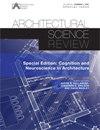设计教育文件的比较以及设计者优先事项、工具和使用者假设之间的脱节
IF 1.9
3区 艺术学
0 ARCHITECTURE
引用次数: 0
摘要
虽然低层次的生理人因设计策略早已在文献中讨论过,但这些设计方法却很少出现在建筑教育和执照要求中。本文章由计算机程序翻译,如有差异,请以英文原文为准。
Comparison of design education documents and the disconnect between designer priorities, tools, and occupant assumptions
While low-level physiological human-factor design strategies have long been discussed in the literature, these design methods are infrequently seen in architecture education and licensure requireme...
求助全文
通过发布文献求助,成功后即可免费获取论文全文。
去求助
来源期刊

Architectural Science Review
ARCHITECTURE-
CiteScore
4.80
自引率
8.70%
发文量
34
期刊介绍:
Founded at the University of Sydney in 1958 by Professor Henry Cowan to promote continued professional development, Architectural Science Review presents a balanced collection of papers on a wide range of topics. From its first issue over 50 years ago the journal documents the profession’s interest in environmental issues, covering topics such as thermal comfort, lighting, and sustainable architecture, contributing to this extensive field of knowledge by seeking papers from a broad geographical area. The journal is supported by an international editorial advisory board of the leading international academics and its reputation has increased globally with individual and institutional subscribers and contributors from around the world. As a result, Architectural Science Review continues to be recognised as not only one of the first, but the leading journal devoted to architectural science, technology and the built environment. Architectural Science Review publishes original research papers, shorter research notes, and abstracts of PhD dissertations and theses in all areas of architectural science including: -building science and technology -environmental sustainability -structures and materials -audio and acoustics -illumination -thermal systems -building physics -building services -building climatology -building economics -ergonomics -history and theory of architectural science -the social sciences of architecture
 求助内容:
求助内容: 应助结果提醒方式:
应助结果提醒方式:


